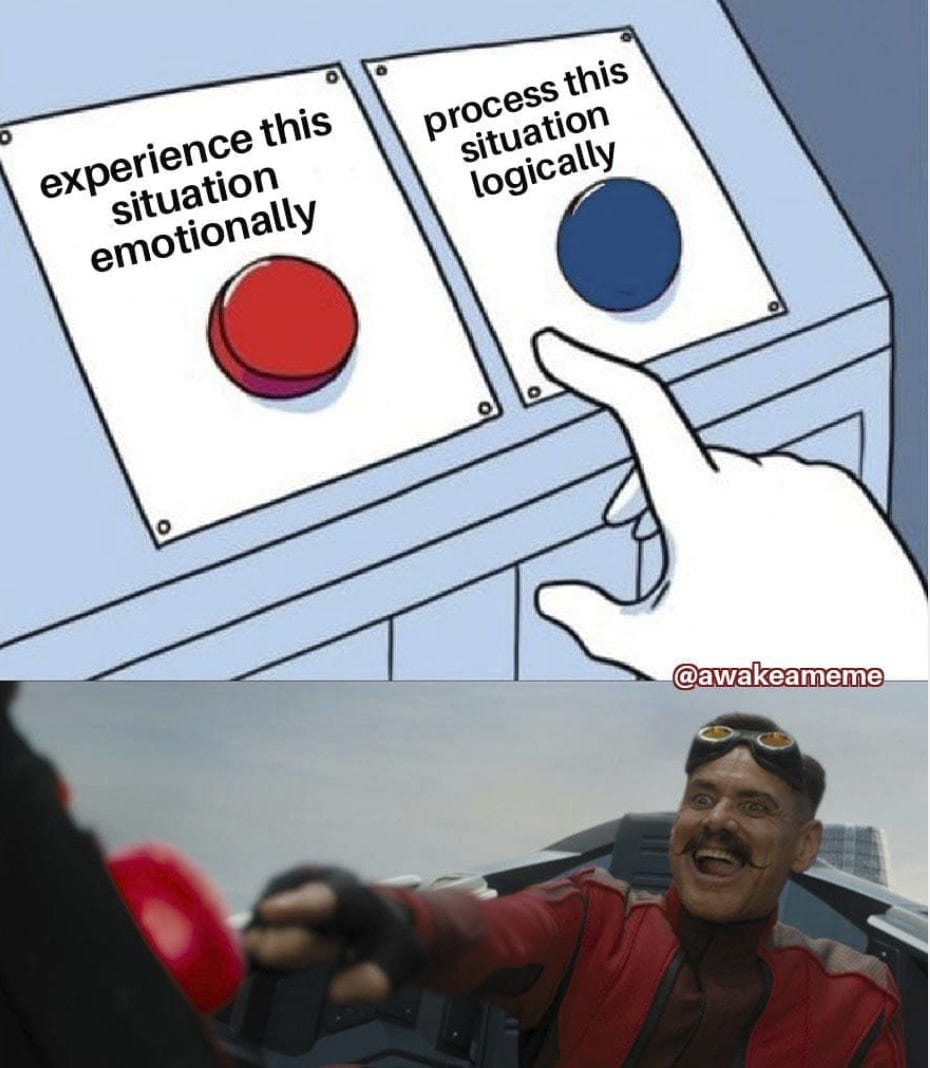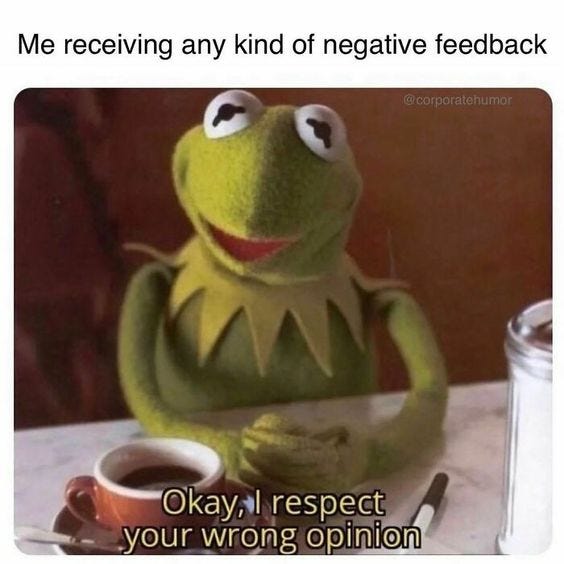Strategy, not self-expression: How to decide what to say when giving feedback
Aim for one goal: behavior change. Sweet, sweet behavior change. Everything else you might want to say? Keep it to yourself.
👋 Hey, it’s Wes. Welcome to my weekly newsletter where I share frameworks for becoming a sharper marketer, operator, and founder. If you’re not a subscriber, here’s what you missed this month:
Subscribe to get free access to these posts, and all future posts.
Giving constructive feedback can be stressful because it’s often accompanied by internal debate about whether to speak up. What if they get upset? What if they retaliate? What if speaking up makes things worse? These are all valid concerns, which is why I love today’s simple framework for giving feedback. In today’s newsletter, you’ll learn:
Why most feedback conversations fail
The difference between strategy vs self-expression
How to optimize for driving behavior change
I originally published a version of this essay in November 2019. If you find it helpful, please consider sharing with your friends and coworkers. Enjoy.
Read time: 7 minutes
When someone says they are open to feedback, it does not mean you should share all your frustrations. Contrary to popular belief, this is not your chance to express how you feel.
A feedback conversation is actually a sales conversation. You are “selling” and pitching the person on why and how to change. This means empathizing with what matters to them, then crafting your message around that. It’s an opportunity to identify and appeal to what is most likely to motivate the person you’re speaking with.
In other words, it’s an opportunity for behavior change. If you’ve ever wondered, Should I say this? Will it hurt or help?, the below framework will help you answer those questions and decide exactly what to say.
Self-expression is why most feedback conversations fail
The reason many feedback conversations go awry is because you think this is a chance to express yourself.
After all, you’ve probably been annoyed with this person’s behavior for a while. You secretly want them to know how they’ve made your life harder. You feel justified in your complaints, and you feel like you have the moral high ground.
So when you finally sit across from the person, you unload all your frustration onto them.
The recipient feels hurt, angry, and defensive. They’re surprised because this is the first time they’re hearing any of this.
And because you focused on sharing your feelings and articulating the damage they did in great detail, at the end of the conversation, they have no idea what you want them to do differently in the future. More importantly, they don’t feel motivated to change.
If nothing changes, then the whole conversation—and all the emotional anxiety on both sides—was wasted.
“Is this strategy or self expression?”
This is one of my favorite and most often used frameworks. I use it for casual and formal feedback conversations, at work and at home, and any time I want to encourage positive behavior.
It’s very simple: Before you speak, ask yourself, Is this strategy or self-expression?
Strategy means only saying things that get you closer to changing the person’s behavior. You should only say things that you strongly believe will incentivize the other person to change in the right direction. Strategy is probably 10% of what you initially want to say.
Self-expression is venting, having the last word, or trying to teach someone a lesson. It’s trying to prove you are right or wanting the person to feel remorse. Anything that isn’t 100% going to encourage the person to improve goes in the self-expression bucket.
Whenever I deviate from strategy—and let myself veer into self-expression territory—I instantly regret it.
How to focus on strategy, not self-expression
Mentally forgive the person
Get any pent up emotions out of your system before the feedback conversation. Talk to your spouse, a trusted friend, or therapist. Feel all the feelings. Get them out. Come to terms with the suffering this person caused you.
Do what it takes so when you’re in the actual feedback conversation, you bring a positive (or at least neutral) energy. This part is very important. Do not skip it.

If you are filled to the brim with resentment or anger, it will easily boil over. It won’t take much to throw you off: a passive-aggressive comment, a smirk, a raise of their eyebrows. Don’t risk letting that derail you. Get the emotion out of your system before you walk into the room.
The energy you bring will set the tone for the conversation. Your recipient will be more likely to hear you when they believe you have good intent. Most of us are bad at faking emotions for very long, so your emotions have to be sincere. This usually includes mentally forgiving the person.
Bathe in your good intent, and let it come through in your body language, facial expressions, content, and tone of voice.
Identify what is most likely to motivate them to change
Write out what you want to say. Then trim 90% of that because it’s probably self-expression, not strategy.
A reminder: Anything that is about having the last word, sharing how they made you feel, getting them to admit wrongdoing… All of that goes in the self-expression bucket.
This isn’t about punishing them for the pain they caused you. They can never repay that anxiety and give you that peace of mind back. You’ve already lived through it. The best thing you can do now is make sure they do better in the future.
They can only do better if they know what to do, feel motivated, and are committed to change. That’s why framing the feedback positively is so important. We feel motivated and committed when we’re excited to do something, not when we’re being punished.
Say only the 10% that will actually change behavior
When you’re in the actual conversation, and anytime you’re about to say something, use the litmus test: Is what I’m about to say strategy or self-expression?
Be specific with what you want the person to do going forward, and pitch why the new behavior is benefits them:
How does this make them even more effective?
How will this allow them to work even better with the people around them?
How does this get them closer to their goals?
How is this a skill they can apply now and in all future roles?
If possible, ask your recipient to share their insights and what they got from the conversation so far. It’s easy for you to monologue, then ask “So do you agree?” They will say, “Yes, I get it.” But what are they agreeing to? What did they actually hear from what you said?
Once you finish talking, ask them:
“I’d love to hear what you think. What parts are resonating most with you?”
Let them say what they heard, what resonated, and what they agree with. This allows them to reflect in real-time and process out loud. When I’ve done this, I’ve realized when direct reports slightly misunderstood what I meant, so it’s a great opportunity to clarify the takeaway together.
The other benefit of letting the other person talk is cognitive dissonance: if they say out loud what they are committed to doing differently, they are reinforcing the idea in their own mind. This is more powerful than you talking for another 20 minutes.
Keep your eyes on the prize
What is the prize? The prize is behavior change. Sweet, sweet behavior change.
Conversations are a mechanism for behavior change. When you realize conversations are a mechanism for behavior change, you can be more strategic about what to say.
As a feedback giver, we sometimes forget to align what we say with our overall goal of changing behavior. When giving hard feedback, most of us focus on our own feelings. We don’t think about how the other person might receive the news.
The minute your recipient gets defensive, it becomes a lot harder to undo the defensiveness and get them to accept what you’re saying. So the trick is: don’t trigger the defensiveness in the first place.
Always be framing
“Strategy, not self expression” applies to situations outside of giving feedback too. When you’re in a situation where you want to persuade, think about what will get you closer to your goal. Ask yourself: Will saying this motivate the person to do what I want them to do? Is this strategy or self-expression?
This applies to any interaction with your customers, coworkers, direct reports, senior leaders, and manager.
Here’s an example from a newsletter reader:
I recently used this approach to get out of an unnecessary work trip. Instead of telling my supervisor that the trip would take me away from my family needlessly and how it would be a hardship for me, I emphasized that the trip would take me away from several important work projects… He gladly excused me from taking the trip.
This works with strangers too. When you interact with a sales associate at a store or on the phone, it’s obvious the person could help you—or they could choose to make your life difficult and be justified in doing so because of company policy. Say only what will motivate them to do what you are hoping for. Trim everything else.
I believe you should even do some amount of framing with your spouse, your family, your friends because selling someone on an idea is the most generous thing you can do.
“But Wes,” you say, “These are close friends and family. Why do I have to think about it from their perspective and do that extra work? Why can’t I just be myself?”
Because we are all a little petty and sensitive inside. You and me included. It’s worth it to empathize with your friends and family and closest colleagues—they deserve your best behavior too. And ultimately, helping the people closest to you feel seen and heard and motivated to improve will improve almost everything you do.
To recap:
Self-expression is why most feedback conversations fail
Start by mentally forgiving the person for their transgressions
Identify what is most likely to motivate them to change
Say only the 10% that will actually change their behavior
Keep your eyes on the prize
Always be framing
If you found this valuable, join 17,000+ readers who will get another essay next week on Wednesday at 8am ET:
I’d love to get your help growing our community of thoughtful, rigorous operators. When you take a moment to refer a friend, you’ll unlock referral rewards of my personal book lists and more. You can grab your custom referral link here:
Thanks for being here,
Wes Kao
PS What was your biggest takeaway? What are you inspired to put into action this week?







I love how I always have things to add to my notes from your articles, Wes.
Great article as usual and it looks like you and I were somewhat of the same friend of mind this past week.
The one I did on Sunday was on framing and thinking about the other persons perspective and how to frame it in those terms too.
I particularly loved these questions you wrote:
> - How does this make them even more effective?
- How will this allow them to work even better with the people around them?
- How does this get them closer to their goals?
- How is this a skill they can apply now and in all future roles?
Thinking about these helps you make sure your frame is thought about from their perspective
This resonates: The only way to give a constructive feedback is to identify what motivates others to change.